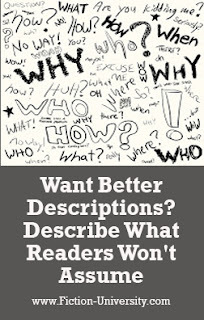Janice Hardy's Blog, page 19
July 20, 2021
Accessing Deep Point of View Via Description—A Writing Exercise!
 By Bonnie Randall
By Bonnie RandallPart of The How They Do It Series
JH: POV is a vital and powerful tool for writers. Bonnie Randall shares a fun writing exercise to sharper your point-of-view skills.
Shout-out to the cable news personality who recently described a certain Canadian Premier as a “demonic hedgehog.” It didn’t just make me laugh, it also inspired this month’s column on accessing Deep Point of View via descriptions.
The way an individual sees the world offers insight into how we, in turn, see that individual. In other words, a benevolent and soft-spoken anchor would be unlikely to pair demons with hedgehogs. A sarcastic wise-guy though…? It’s demonic hedgehogs all the way, baby!
Think of the last time a character in your fiction was in a setting. Was the sun blistering their skin, or was it beaming? Did that same sun illuminate everything they’d rather not look at, or did they have to squint away their chronic hangover? Andrew, the hero of my paranormal suspense Within The Summit’s Shadow—and an acerbic, pessimistic kinda guy—travels to Vancouver for a stakeout where he “Sat in the pissing rain. Typical Vancouver.”
Continue ReadingWritten by Janice Hardy. Fiction-University.com
Published on July 20, 2021 03:54
July 19, 2021
Want Better Descriptions? Describe What Readers Won't Assume
 By Janice Hardy, @Janice_Hardy
By Janice Hardy, @Janice_Hardy Writing better descriptions is easy when you take advantage of your point-of-view character.
I always chuckle a bit when I write about description, because I dislike writing description. I’m much more intrigued by what characters say, think, and do than what things look like, but description is necessary to craft a well-rounded story. In some genres, it’s vital.
Lucky for me, my attitude toward description actually helped me develop tricks to do the most with the fewest words possible—a valuable skill for any writer. Instead of writing a paragraph or two detailing what a room looks like, I assume the reader knows what a room looks like, then I pick specific details about that particular room, and show it through my point-of-view character.
I learned this trick a decade ago from author Kathleen Duey at the Decatur Book Festival in Georgia. During a panel, she brilliantly said, “Describe what the reader won't assume.”
Continue ReadingWritten by Janice Hardy. Fiction-University.com
Published on July 19, 2021 04:00
July 17, 2021
WIP Diagnostic: Is This Working? A Closer Look at Piquing Reader Interest on Page One
 Critique by Maria D'Marco
Critique by Maria D'Marco WIP Diagnostics is a weekly column that studies a snippet of a work in progress for specific issues. Readers are encouraged to send in work with questions, and we diagnose it on the site. It’s part critique, part example, and designed to help the submitter as well as anyone else having a similar problem.
If you're interested in submitting to WIP Diagnostics, please check out these guidelines.
Submissions currently in the queue: Five
Please Note: As of today, critique slots are booked through August 21.
This week’s question:
By diving into the inciting incident in the first 280 words of ch 1, will it peak the reader’s interest or is it too jarring?
Market/Genre: Paranormal Mystery
On to the diagnosis…
Continue ReadingWritten by Janice Hardy. Fiction-University.com
Published on July 17, 2021 04:52
July 15, 2021
Twelve Story Ending Twists That Don't Work
 By Rayne Hall, @RayneHall
By Rayne Hall, @RayneHallPart of the Focus on Short Fiction Series
JH: Some twists have been written to death. Rayne Hall shares 12 endings you should avoid.
Certain short story endings will almost inevitably lead to rejection. What are they, and why should you avoid them?
1. "And then I woke up. It was only a dream."
You've created an exciting story, and your readers sit on the edge of their seat to await the outcome... and then you reveal that none of it happened. What a let down!
In my role as an anthology editor and contest judge, I've received quite a few of those, mostly from novice writers who are submitting their first stories. Other editors and writing contests judges are fed up with them, too. Often, when I chat with editors and judges, one of them says, "Today I got a big batch of 'it was only a dream' submissions," and the rest of us just roll our eyes and groan in sympathy.
Continue ReadingWritten by Janice Hardy. Fiction-University.com
Published on July 15, 2021 03:00
July 14, 2021
Plot Your Way Back from an Unruly Idea
 By Kristin Durfee, @KristinDurfee
By Kristin Durfee, @KristinDurfee
Part of The How They Do It Series
JH: Finding the plot in your idea can sometimes send you so far off track you lose the idea. Kristin Durfee shares tips on wrangling an idea back on track.
Kristin Durfee is the author of The Four Corners Trilogy (Black Opal Books), MASS (Orange Blossom Publishing), and Touch (Voyage Literary Journal) as well as short stories for adults appearing in several anthologies. She resides in Central Florida and when not enjoying the sun with her husband, son, and two quirky dogs, you can usually find her on a run, horseback ride, or wandering around a theme park.
Website | Goodreads | Facebook| Twitter|
Take it away Kristin…
Continue ReadingWritten by Janice Hardy. Fiction-University.com
Published on July 14, 2021 03:00
July 13, 2021
Selling Short Fiction, Part One: The Basics
 By José Pablo Iriarte, @LabyrinthRat
By José Pablo Iriarte, @LabyrinthRatPart of the Focus on Short Fiction Series
JH: There are a few things you ought to know before diving into the short story market. José Pablo Iriarte answers questions writers often have with short fiction.
When my spouse and I give presentations to conferences and writing groups, I'm usually the grumpy one who wants to focus on craft more than business, because I believe no gimmick or pitch is going to make you a selling writer if your craft is not professional grade.
That said, I've seen enough red flags in magazine practices, in contest submission guidelines, and in assumptions expressed by new writers to make be feel that we definitely should talk about the business side of things, when you're a short story writer. You might have a sense, from reading Fiction University and from other sources, of how you approach novel publication. Some of those lessons overlap into short fiction, but in many ways the short fiction landscape is unique, so it's worth talking a little bit about how to seek publication.
Continue ReadingWritten by Janice Hardy. Fiction-University.com
Published on July 13, 2021 05:20
July 12, 2021
Do or Do Not. There is No Try: Clarifying What Your Characters Do
 By Janice Hardy, @Janice_Hardy
By Janice Hardy, @Janice_Hardy The word “try” can send all the wrong signals to your reader.
Characters “try to” do a lot of things in stories. They try to get up, they try to hide, they try to hold back tears. But what the writer really means, is the character got up, they hid behind the couch and were found anyway, or they blinked back tears welling in their eyes.
The “try” isn’t describing the action, it’s describing the motive, which is another form of telling, not showing. The trying weakens the writing, and isn’t putting enough of what’s actually happening on the page for readers to understand the action.
Not that “trying to” act is a bad thing. If the motive is more important than the action, “trying” works just fine and conveys what the author wants readers to know. But more often than not, “trying” is unclear, and readers are left wondering if the character accomplished what they tried to do or not.
Continue ReadingWritten by Janice Hardy. Fiction-University.com
Published on July 12, 2021 03:00
July 10, 2021
WIP Diagnostic: Is This Working? A Closer Look at Narrative Flow in an Opening Scene
 Critique by Janice Hardy, @Janice_Hardy
Critique by Janice Hardy, @Janice_Hardy WIP Diagnostics is a weekly column that studies a snippet of a work in progress for specific issues. Readers are encouraged to send in work with questions, and we diagnose it on the site. It’s part critique, part example, and designed to help the submitter as well as anyone else having a similar problem.
If you're interested in submitting to WIP Diagnostics, please check out these guidelines.
Submissions currently in the queue: Five
Please Note: As of today, critique slots are booked through August 14.
This week’s questions:
1. The main threat hasn’t materialized yet, but do you get the sense that something interesting might happen soon? In other words, does it pique your curiosity enough to keep reading?
2. Is the POV character’s voice coming across?
3. How is the balance between dialogue, internalization, and description? My writing tends to be short on description, but I’m worried I may have gone overboard and now have too much.
Market/Genre: Science Fiction
On to the diagnosis…
Continue ReadingWritten by Janice Hardy. Fiction-University.com
Published on July 10, 2021 05:34
July 8, 2021
How to Stay Motivated and Keep Writing
 By Laurence MacNaughton, @LMacNaughton
By Laurence MacNaughton, @LMacNaughtonPart of The Writer's Life Series
JH: A lack of motivation is a vicious cycle—the less motivated we are, the worse we feel, which only kills our motivation further. Laurence MacNaughton shares tips on how to stay motivated and keep writing.
Like the rough draft of a novel, life doesn't follow a carefully planned outline. Bad things happen. Circumstances change. Life gets overwhelming. At some point, you may realize that you've stopped writing. And the idea of getting started again looms over you like a sheer cliff that's impossible to climb. How can you ever get motivated to finish that book?
Don't worry. Every writer has been there, at one point or another. The writers who become successful are the ones who find a way to overcome obstacles and finish their novels. You can be successful too, and here's how.
Continue ReadingWritten by Janice Hardy. Fiction-University.com
Published on July 08, 2021 03:00
July 7, 2021
On the Road: Tips on Creating Unique Character Voices

By Janice Hardy, @Janice_Hardy
Hi all!
I'm guest posting at Writers in the Storm today, with 5 Steps to Creating a Unique Character Voice.
Here's a sneak peek:
Create unique character voices by varying how they communicate with other characters.
I’m one of those writers who needs to put my characters through a first draft before I figure out who they really are. Tossing them into trouble and watching how they wrangle their way out of it helps me get to know them. Their dialogue and voices are usually interchangeable at first. It’s more about what they say than how they say it, or even why they say it.
The voices usually come to me as I write, and by the end of the first draft, I’ve written snippets of voice that let me see and hear the characters. On draft two, I develop those snippets into fleshed-out characters.
Since I don’t hear my characters first (like many writers do), I make conscious choices about their voices, and craft them same as I do a setting or the plot. Which keeps my authorial nose out of my character’s business, and lets them be who they are—not extensions of who I am. Characters who all sound like the protagonist or the author is a common first-draft issue for a lot of writers.
The author’s voice sometimes gets in the way of the character’s voice.
Read the rest of the article at WITS.Written by Janice Hardy. Fiction-University.com
Published on July 07, 2021 03:25



